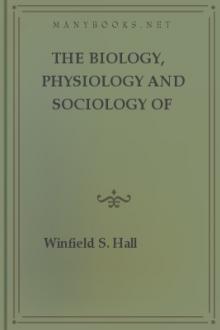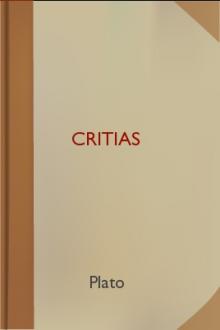Illusions, James Sully [speld decodable readers .TXT] 📗

- Author: James Sully
- Performer: -
Book online «Illusions, James Sully [speld decodable readers .TXT] 📗». Author James Sully
A somewhat similar illusion as to direction occurs in auditory perception. The sense of direction by the ear is known to be due in part to the action of the auricle, or projecting part of the ear. This collects the air-waves, and so adds to the intensity of the sounds, especially those coming from in front, and thus assists in the estimation of direction. This being so, if an artificial auricle is placed in front of the ears; if, for example, the two hands are each bent into a sort of auricle, and placed in front of the ears, the back of the hand being in front, the sense of direction (as well as of distance) is confused. Thus, sounds really travelling from a point in front of the head will appear to come from behind it.
Again, the perception of the unity of an object is liable to be falsified by the introduction of exceptional circumstances into the sense-organ. This is illustrated in the well-known experiment of crossing two fingers, say the third and fourth, and placing a marble or other small round object between them. Under ordinary circumstances, the two lateral surfaces (that is, the outer surfaces of the two fingers) now pressed by the marble, can only be acted on simultaneously by two objects having convex surfaces. Consequently, we cannot help feeling the presence of two objects in this exceptional instance. The illusion is analogous to that of the stereoscope, to be spoken of presently.
Exceptional External Arrangements.
Passing now to those cases where the exceptional circumstance is altogether exterior to the organ, we find a familiar example in the illusions connected with the action of well-known physical forces, as the refraction of light, and the reflection of light and sound. A stick half-immersed in water always looks broken, however well we may know that the appearance is due to the bending of the rays of light. Similarly, an echo always sounds as though it came from some object in the direction in which the air-waves finally travel to the ear, though we are perfectly sure that these undulations have taken a circuitous course. It is hardly necessary to remind the reader that the deeply organized tendency to mistake the direction of the visible or audible object in these cases has from remote ages been made use of as a means of popular delusion. Thus, we are told by Sir D. Brewster, in his entertaining Letters on Natural Magic (letter iv.), that the concave mirror was probably used as the instrument for bringing the gods before the people. The throwing of the images formed by such mirrors upon smoke or against fire, so as to make them more distinct, seems to have been a favourite device in the ancient art of necromancy.
Closely connected with these illusions of direction with respect to resting objects, are those into which we are apt to fall respecting the movements of objects. What looks like the movement of something across the field of vision is made known to us either by the feeling of the ocular muscles, if the eye follows the object, or through the sequence of locally distinct retinal impressions, if the eye is stationary. Now, either of these effects may result, not only from the actual movement of the object in a particular direction, but from our own movement in an opposite direction; or, again, from our both moving in the first direction, the object more rapidly than ourselves; or, finally, from our both moving in an opposite direction to this, ourselves more rapidly than the object. There is thus always a variety of conceivable explanations, and the action of past experience and association shows itself very plainly in the determination of the direction of interpretation. Thus, it is our instinctive tendency to take apparent movement for real movement, except when the fact of our own movement is clearly present to consciousness, as when we are walking, or when we are sitting behind a horse whose movement we see. And so when the sense of our own movement becomes indistinct, as in a railway carriage, we naturally drift into the illusion that objects, such as trees, telegraph posts, and so on, are moving, when they are perfectly still. Under the same circumstances, we are apt to suppose that a train which is just shooting ahead of us is moving slowly.
Similar uncertainties arise with respect to the relative movement of two objects, the eye being supposed to be fixed in space. When two objects seem to pass one another, it may be that they are both moving in contrary directions, or that one only is moving, or finally, that both are moving in the same direction, the one faster than the other. Experience and habit here again suggest the interpretation which is most easy, and not unfrequently produce illusion. Thus, when we watch clouds scudding over the face of the moon, the latter seems moving rather than the former, and the illusion only disappears when we fix the eye on the moon and recognize that it is really stationary. The probable reason of this is, as Wundt suggests, that experience has made it far easier for us to think of small objects like the moon moving rapidly, than of large masses like the clouds.[36]
The perception of distance, still more than that of direction, is liable to be illusory. Indeed, the visual recognition of distance, together with that of solidity, has been the great region for the study of "the deceptions of the senses." Without treating the subject fully here, I shall try to describe briefly the nature and source of these illusions.[37]
Confining ourselves first of all to near objects, we know that the smaller differences of distance in these cases are, if the eyes are at rest, perceived by means of the dissimilar pictures projected on the two retinas; or if they move, by this means, together with the muscular feelings that accompany different degrees of convergence of the two eyes. This was demonstrated by the famous experiments of Wheatstone. Thus, by means of the now familiar stereoscope, he was able to produce a perfect illusion of relief. The stereoscope may be said to introduce an exceptional state of things into the spectator's environment. It imitates, by means of two flat drawings, the dissimilar retinal pictures projected by a single solid receding object, and the lenses through which the eyes look are so constructed as to compel them to converge as though looking on a single object. And so powerful is the tendency to interpret this impression as one of solidity, that even though we are aware of the presence of the stereoscopic apparatus, we cannot help seeing the two drawings as a single solid object.
In the case of more remote objects, there is no dissimilarity of the retinal pictures or feelings of convergence to assist the eye in determining distance. Here its judgment, which now becomes more of a process of conscious inference, is determined by a number of circumstances which, through experience and association, have become the signs of differences of depth in space. Among these are the degree of indistinctness of the impression, the apparent or retinal magnitude (if the object is a familiar one), the relations of linear perspective, as the interruption of the outline of far objects by that of near objects, and so on. In a process so complicated there is clearly ample room for error, and wrong estimates of distance whenever unusual circumstances are present are familiar to all. Thus, the inexperienced English tourist, when in the clear atmosphere of Switzerland, where the impressions from distant objects are more distinct than at home, naturally falls into the illusion that the mountains are much nearer than they are, and so fails to realize their true altitude.
Illusions of Art.
The imitation of solidity and depth by art is a curious and interesting illustration of the mode of production of illusion. Here we are not, of course, concerned with the question how far illusion is desirable in art, but only with its capabilities of illusory presentment; which capabilities, it may be added, have been fully illustrated in the history of art. The full treatment of this subject would form a chapter in itself; here I can only touch on its main features.
Pictorial art working on a flat surface cannot, it is plain, imitate the stereoscope, and produce a perfect sense of solidity. Yet it manages to produce a pretty strong illusion. It illustrates in a striking manner the ease with which the eye conceives relations of depth or relief and solidity. If, for example, on a carpet, wall-paper, or dress, bright lines are laid on a dark colour as ground, we easily imagine that they are advancing. The reason of this seems to be that in our daily experience advancing surfaces catch and reflect the light, whereas retiring surfaces are in shadow.[38]
The same principle is illustrated in one of the means used by the artist to produce a strong sense of relief, namely, the cast shadow. A circle drawn with chalk with a powerful cast shadow on one side will, without any shading or modelling of the form, appear to stand out from the paper, thus:
FIG. 1.
The reason is that the presence of such a shadow so forcibly suggests to the mind that the object is a prominent one intervening between the light and the shaded surface.[39]
Even without differences of light and shade, by a mere arrangement of lines, we may produce a powerful sense of relief or solidity. A striking example of this is the way in which two intersecting lines sometimes appear to recede from the eye, as the lines a a', b b', in the next drawing, which seem to belong to a regular pattern on the ground, at which the eye is looking from above and obliquely.
FIG. 2.
Again, the correct delineation of the projection of a regular geometrical figure, as a cube, suffices to give the eye a sense of relief. This effect is found to be the more striking in proportion to the familiarity of the form. The following drawing of a long box-shaped solid at once seems to stand out to the eye.
FIG. 3.
This habitual interpretation of the flat in art as answering to objects in relief, or having depth, can only be understood when it is remembered that our daily experience gives us myriads of instances in which the effect of such flat representations answers to solid receding forms. That is to say, in the case of all distant objects, in the perception of which the dissimilarity of the retinal pictures and the feeling of convergence take no part, we have to interpret solidity, and relations of nearer and further, by such signs as linear perspective and cast shadow. On the other hand, it is only in the artificial life of indoors, on our picture-covered walls, that we experience such effects without discovering corresponding realities. Hence a deeply organized habit of taking these impressions as answering to the solid and not to the flat. If our experience had been quite different; if, for example, we had been brought up in an empty room, amid painted walls, and had been excluded from the sight of the world of receding objects outside, we might easily have formed an exactly opposite





Comments (0)